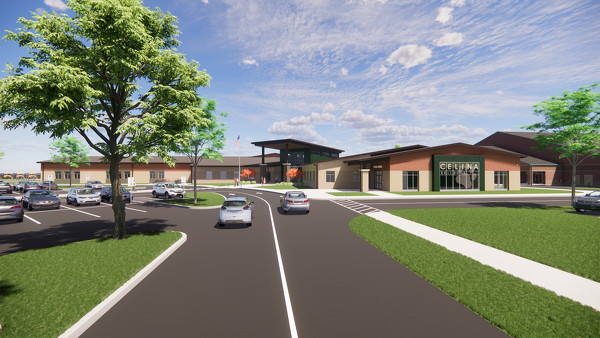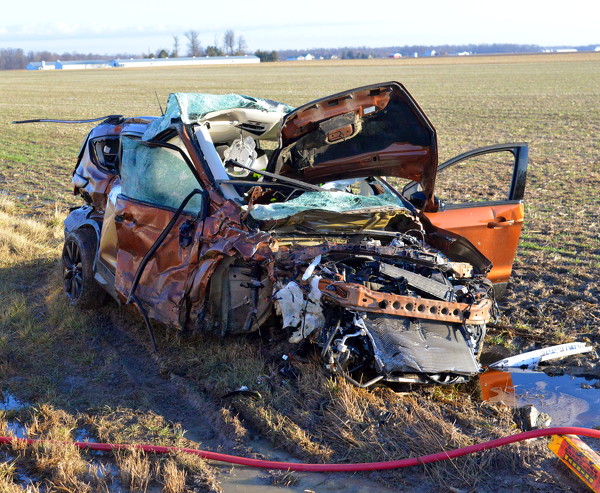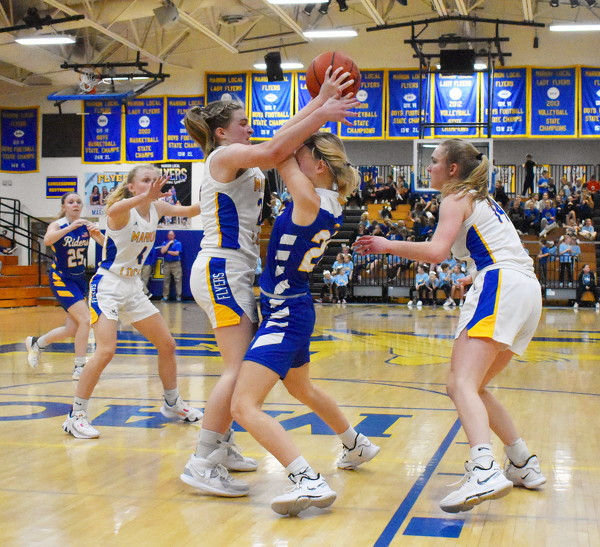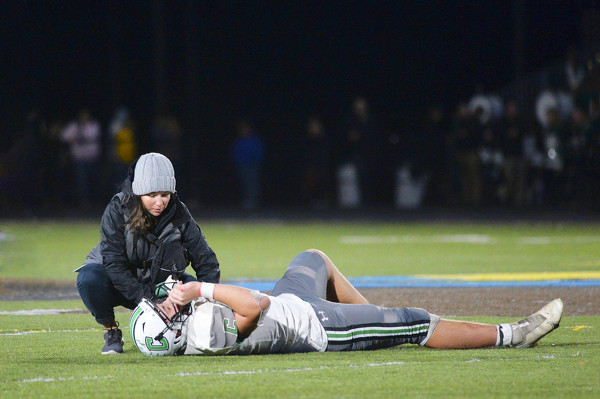
Celina High School trainer Allie Wright tends to Celina's Dalton Chilcoat during a game against St. Marys in October. Chilcoat did not suffer serious injuries.
NFL football player Damar Hamlin's on-field injury on Jan. 2 before a national audience compelled Celina High School athletic trainer Allie Wright to think about the emergency action plan for Celina athletic events.
Hamlin, a safety for the Buffalo Bills, went into cardiac arrest after a collision on Monday Night Football against the Cincinnati Bengals. Bills' trainers resuscitated him on the field.
"Unfortunately, I feel that we've kind of slacked off in that area in the high school setting," Wright said. "I know Tiffany (Rutschilling) at Coldwater, she teaches CPR to her coaches, which gives her the opportunity to go over that with them. I know this event has made me want to sit down with our athletic director and kind of nail out some of those things we're lacking in."
In the aftermath of Hamlin's incident, which left the 24-year-old player hospitalized until Jan. 12, local schools detailed their emergency action plans for cardiac events and other medical emergencies arising during athletic play.
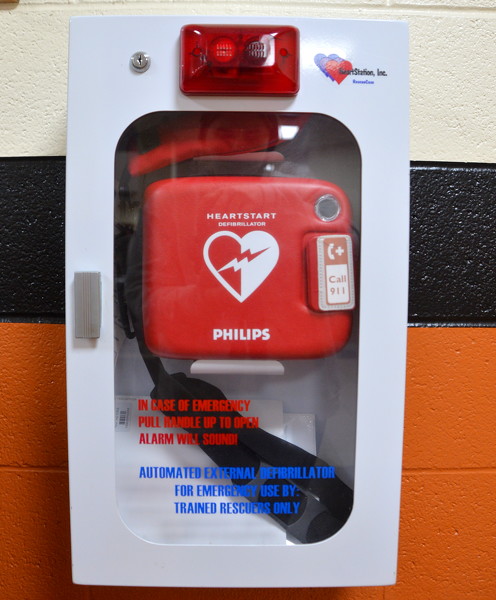
One of Coldwater's five AEDs is mounted to the wall just outside the northeast entrance of the Palace.
At least one Automatic Emergency Defibrillator (AED) - which along with the quick action of trainers is credited with saving Hamlin's life - is available at contests hosted by the area schools who responded to The Daily Standard's survey.
AEDs are portable, life-saving devices designed to treat people experiencing sudden cardiac arrest, a medical condition in which the heart stops beating suddenly and unexpectedly, according to U.S. Food & Drug Administration.
"All of our athletic facilities have an AED accessible if needed," said Celina athletic director Derek Wenning. "The Celina Fire Department attends all varsity football games and other athletic events when requested. Also, at all of our varsity football games we have a doctor on the sideline."
New Knoxville athletic director Kay Webb issued a similar statement about emergency personnel and equipment on hand at sporting contests in the district.
"We have a trainer on site at every home event and during most practices. These services are provided by Grand Lake Health. Our trainer communicates with all opponents about medical care when we travel," Web said.
Emergency actions plans have been established for each New Knoxville venue, she continued.
"All athletic facilities have an AED located at the facility or a portable AED unit is brought to the facility by the trainer when practices/competitions are taking place," Web pointed out.
Coldwater athletic trainer Tiffany Rutschilling said there are five AEDs across Coldwater's different venues.
"Some of the other athletic trainers I know carry an AED with them," Wright said. "I would kind of like to push for that more for myself. It's a little spread out all over the place, so just to have that quicker access."
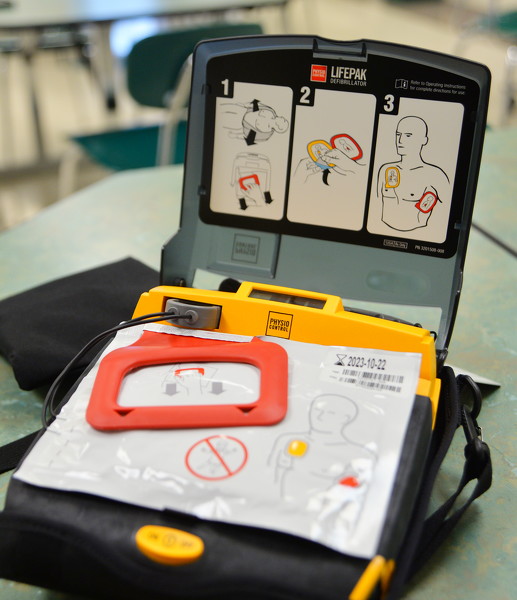
Celina High School's AED is located near the men's restroom of the front lobby. Upon opening, the AED prompts the user with vocal commands on how to properly use the device.
AEDs are designed to be easy to use even without prior instruction. Rutschilling's travel AED gives vocal commands and has diagrams showing how to apply the pads. It then determines whether an electrical shock will restore the heart's natural rhythm. If warranted, the shock is automatically administered.
If a shock will not help, the AED instructs the user to resume CPR.
Kim Smith, a nurse for Celina schools who gave CPR certification to Celina coaches up until 2018, said that the AEDs are inspected every month.
Coaches are also required by the Ohio Department of Education and the Ohio High School Athletic Association to renew CPR certification every two years. Coaches are trained with an AED and required to take a written test, and Ohio schools require students to be exposed to CPR and AED training.
Smith said AED training helps familiarize coaches with using the device.
"They were kind of nervous about it," Smith said. "It's something new, it's electronic. They're worried they're going to give too much or not enough, but you can't make those kind of mistakes."
Administrators for St. Henry, Marion Local, Minster, New Bremen and Fort Recovery detailed their own emergency action plans, which also feature AEDs available at all events. Like Rutschilling, St. Henry's athletic trainer carries a travel AED with her.
Marion Local high school principal and football coach Tim Goodwin said the district contracts with Community Sports and Therapy to have a trainer at both practices and home games.
Fort Recovery athletic director Holly Gann noted all games have an AED available. A trainer is present at all high school home games and some middle school games.
Also, the full emergency action plan is posted in multiple places in every facility. Gann said it had been activated three times in the 2021-22 season in cases where athletes got overheated or had trouble breathing.
Local student-athletes also undergo physical examinations.
"We take the health of our student athletes very seriously," said Minster athletic director Josh Clune. "It starts with the athletes required to have a yearly athletic physical. All student athletes are also required to go through IMPACT concussion testing which is administered by our athletic trainer."
The testing, Clune said, provides an athlete's baseline for the trainer to use in the event of potential head injury.
"Athletes with head injuries then must pass a return to play protocol prior to being fully released," Clune said. "This can take anywhere from days to weeks or longer."
A number of cardiologists have publicly speculated that Hamlin's cardiac arrest was the result of commotio cordis, which occurs when a blow to the chest during a 30-millisecond window in the heart's electrical rhythm causes the heart to stop.
Commotio cordis is most common in younger athletes, whose ribcages are still growing.
"We're taught about it in school, just something to be aware of," Wright said. "We definitely hear about it more in terms of baseball or lacrosse, where projectiles are being thrown. Doesn't happen very often, but it is something we are taught and prepared to handle."
Rutschilling recalled an apparent case of commotio cordis in a summer baseball tournament where a player from Bryan was hit by a line drive and died with no AED available. In response, AEDs are given out as prizes to the winning teams, and the ones Coldwater has won are at the local parks in the summer.
Such cases have been few and far between. Smith couldn't recall any cases of cardiac arrest among students, and Wright said the most serious incident she'd faced in four years as Celina's trainer was a cross country runner who passed out from heat illness and had to be taken to the hospital.
Rutschilling, in 11 years at Coldwater, also has never faced a cardiac event among her students, but said she's had some with pre-existing conditions she watches closely and at times advises to take a step back.
"I've been here long enough that I know my athletes, and if they're just not acting like they normally do, I'll check up with them: 'Feeling okay?'" Rutschilling said. "Most of them will be honest and say, 'This is bothering me today,' and I'll say, 'OK, take a step back.' My coaches already know about it, so I'm not fighting the coaches when I pull a kid, especially when they have a pre-existing condition. They don't want to have to deal with what happened (to Hamlin) on the field."
Rutschilling, though, was present for one of the most serious local cases, when Coldwater's Shane Homan suffered a spinal injury in a junior varsity football game in 2018.
"Even before I got to him, I knew something wasn't right," she said. "Shane was the type of guy, he'd get hit, and he'd bounce right back up. Well, he rolled over. And I was like, 'Crap.' I knew something was wrong before I even got to him. That's part of knowing my kids…
"The hardest part, dealing with an injury like Shane's, is knowing that I can do absolutely nothing. I can reassure him. I can keep him calm. I can make sure he doesn't make anything worse. But I can't fix anything. It's beyond my level of care… (and that incident) scared a lot of my kids. I had seven or eight kids not play football the next year because of that injury."
In that event she said the emergency action plan ran smoothly. The incident, though, did bring about a couple changes. Coldwater's coaches further emphasized proper tackling technique, and they replaced the team's shoulder pads with a model easier to remove in case of serious injury.
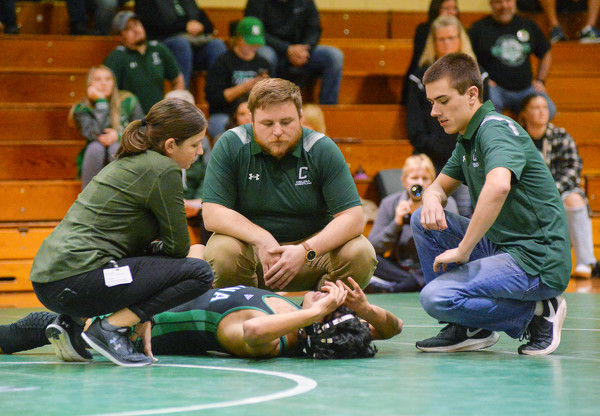
Trainer Allie Wright and Celina assistant coaches Kevin Lockwood and Brycen Miracle tend to Tony Chavez during a wrestling match against Kenton in December. Chavez was able to finish the match. He had a minor back injury.
Trainers in Ohio have to pass a national certification exam, and new trainers are now required to have at least a master's degree, which includes thousands of hours of field work in high schools, colleges or clinics, according to Rutschilling. ;Ohio also requires athletic trainers to be licensed through the state, which requires passing a test on Ohio laws around treating athletes. They also need to remain CPR/AED certified at the level of nurses or doctors.
Wright said the biggest thing for parents and spectators to know is trainers are prepared to handle medical emergencies.
"There are trained professionals around, and we're going to do our best," she said. "We do have a protocol in place. I know it can be scary for parents to think about with their kids in sports, but just try to trust people, know your place, not get in the way."
- Reporters William Kincaid, Bob Tomaszewski, Erin Gardner and Leslie Gartrell contributed to this story.
